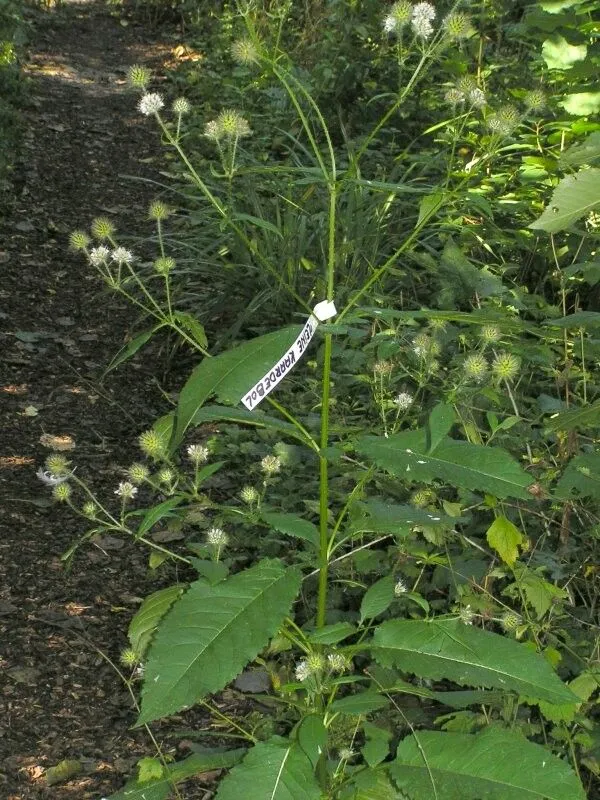
Author: L.
Bibliography: Sp. Pl.: 97 (1753)
Year: 1753
Status: accepted
Rank: species
Genus: Dipsacus
Vegetable: False
Observations: Europe to N. Iran
Small teasel, scientifically known as Dipsacus pilosus, is a captivating plant species that belongs to the Caprifoliaceae family. Originally described in Linnaeus’s seminal work, “Species Plantarum,” published in 1753, this plant has intrigued botanists and plant enthusiasts for centuries.
Native to regions spanning Europe to Northern Iran, the small teasel thrives in a variety of habitats, often favoring regions with abundant moisture. It can frequently be found along the edges of woodlands, in meadows, and by riversides, where it enjoys partial shade and rich, well-drained soils.
The small teasel is an herbaceous biennial plant, meaning it generally completes its biological lifecycle over two years. In its first year, the plant forms a basal rosette of leaves. These leaves are typically oval-shaped, featuring a characteristic hairy texture that is a hallmark of the speices. In its second year, the small teasel sends up a tall flowering stem that can reach up to 1.5 meters in height.
The flowering structures of the small teasel are distinctive and quite attractive. The flowers are densely packed into cylindrical heads that can be elongated up to 5-6 cm in length. Each flower head is surrounded by a series of bracts, which give the appearance of a spiky thistle. The individual flowers within the head are small, tubular, and typically white, occasionally tinged with subtle lavender hues. These blossoms are known to attract a variety of pollinators, including bees and butterflies, contributing to the plant’s ecological value.
Following the flowering period, small teasel produces seeds that are dispersed primarily by wind and water, allowing the plant to colonize new areas and sustain its population effectively.
Small teasel is not only a plant of ecological interest but also holds potential in horticultural settings. Though it is not as commonly cultivated as some of its relatives, it can be a valuable addition to wildflower gardens and naturalized landscapes, where its unique flower heads and robust growth habit can add visual interest.
In summary, Dipsacus pilosus, or small teasel, is a fascinating and ecologically valuable member of the Caprifoliaceae family. Its presence from Europe to Northern Iran and its striking appearance throughout its lifecycle make it an appealing subject for further study and appreciation in both natural and cultivated environments.
Deu: behaarte karde
Dan: håret kartebolle
Fra: cardère velue
Swe: hårig kardvädd
Nld: kleine kaardebol, kleine kaardenbol
Eng: small teasel, shepherd’s rod
Nob: hårkardeborre
Nno: hårkardeborre
Cym: cribau’r-pannwr bach, ffon y bugail, gwialen y bugail
En: Small Teasel, Shepherd’s Rod, Small Teazle
Ar: ممشقة شعراء
Ca: Cardó pelut
Hr: Dlakava češljugovina
Da: Håret kartebolle
Nl: Kleine Kaardebol, Kleine kaardenbol
Fi: Karvakarstaohdake
Fr: Cardère velue, Cardère poilue, Verge à pasteur
De: Behaarte Karde, Behaarte-Karde, Hirtenstab
Ga: Leadán úcaire beag
It: Scardaccione peloso
Li: Kaardebol
Nb: Hårkardeborre
Nn: Hårkardeborre
Fa: خواجهباشی صغیر
Pl: Szczeć owłosiona
Sv: Hårig kardvädd
Cy: Cribau’r-pannwr bach, Ffon y Bugail, Gwialen y Bugail
: Small teasel
© copyright of the Board of Trustees of the Royal Botanic Gardens, Kew.
© copyright of the Board of Trustees of the Royal Botanic Gardens, Kew.
© copyright of the Board of Trustees of the Royal Botanic Gardens, Kew.
Taken Jul 29, 2020 by cirse (cc-by-sa)
Taken Jul 29, 2021 by Tim Behrens (cc-by-sa)
Taken Jul 29, 2021 by Tim Behrens (cc-by-sa)
Taken Nov 25, 2011 by Martin Bishop (cc-by-sa)
Taken Jul 6, 2022 by Gaël Covain (cc-by-sa)
Taken Aug 16, 2018 by Manu Pacha (cc-by-sa)
Taken Aug 16, 2018 by Manu Pacha (cc-by-sa)
Taken Aug 16, 2018 by Manu Pacha (cc-by-sa)
Taken Aug 16, 2018 by Manu Pacha (cc-by-sa)
Taken Aug 16, 2018 by Manu Pacha (cc-by-sa)
Taken Aug 26, 2022 by Carmelo Zerbo (cc-by-sa)
Taken Aug 22, 2020 by Dominique Wernert (cc-by-sa)
Taken Aug 9, 2013 by Tela Botanica − Yoan MARTIN (cc-by-sa)
Taken Aug 24, 2007 by Rinusz (cc-by-sa)
Taken Aug 16, 2018 by Manu Pacha (cc-by-sa)
Taken May 23, 2014 by Tela Botanica − Françoise CARLE (cc-by-sa)
Taken Sep 19, 2020 by Patrick Behr (cc-by-sa)
Taken Aug 16, 2018 by Manu Pacha (cc-by-sa)
Taken Aug 16, 2018 by Manu Pacha (cc-by-sa)
Taken Aug 16, 2018 by Manu Pacha (cc-by-sa)
Taken Aug 22, 2020 by Dominique Wernert (cc-by-sa)
Taken Aug 22, 2020 by Dominique Wernert (cc-by-sa)
Taken Aug 26, 2022 by Carmelo Zerbo (cc-by-sa)
Taken Jul 6, 2022 by Gaël Covain (cc-by-sa)
Taken Aug 24, 2007 by Rinusz (cc-by-sa)
Taken Jul 29, 2013 by Tela Botanica − Emmanuel STRATMAINS (cc-by-sa)
Taken Jan 1, 1970 by Photoflora – L’Abbé COSTE (©)
Taken Jul 31, 1849 by Tela Botanica − Herbier PONTARLIER-MARICHAL (cc-by-sa)
Taken Feb 18, 2017 by Yoan MARTIN (cc-by-sa)
Taken Feb 18, 2017 by Yoan MARTIN (cc-by-sa)
Ph maximum: 7.5
Ph minimum: 7.0
Light: 7
Atmospheric humidity: 7
Bloom months: [‘jun’, ‘jul’, ‘aug’, ‘sep’]
Soil nutriments: 7
Family: Myrtaceae Author: (F.Muell.) K.D.Hill & L.A.S.Johnson Bibliography: Telopea 6: 402 (1995) Year: 1995 Status:…
Family: Rubiaceae Author: Pierre ex A.Froehner Bibliography: Notizbl. Bot. Gart. Berlin-Dahlem 1: 237 (1897) Year:…
Family: Sapindaceae Author: Koidz. Bibliography: J. Coll. Sci. Imp. Univ. Tokyo 32(1): 38 (1911) Year:…
Family: Asteraceae Author: A.Gray Bibliography: Pacif. Railr. Rep.: 107 (1857) Year: 1857 Status: accepted Rank:…
Family: Fabaceae Author: Medik. Bibliography: Vorles. Churpfälz. Phys.-Ökon. Ges. 2: 398 (1787) Year: 1787 Status:…
Family: Aspleniaceae Author: (Cav.) Alston Bibliography: Bull. Misc. Inform. Kew 1932: 309 (1932) Year: 1932…